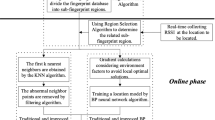Abstract
Context-aware computing refers to an application’s ability to adapt to changing circumstances and respond based on the context of use. The estimation of user location is crucial to many context-aware applications. In this paper we propose a technique to infer user location in a wireless LAN inside buildings based on backpropagation neural networks. The strengths of the radio-frequency (RF) signals arriving from several access points in a wireless LAN are related to the position of the mobile device. Estimating the position of the mobile device from the RF signals is a complex inverse problem since the signals are affected by the heterogeneous nature of the environment. Backpropagation neural networks represent a viable alternative to tackle this problem given their property of generalizing from examples. Experimental results provide an average distance error of 1.87 meters from the real location, which is considered to be adequate for many applications. A simple contextaware application is presented as an example. The estimation errors obtained are similar to those using k-nearest neighbors; however the approach presented here uses less memory, an important concern for handheld devices with limited storage capacity an operating on relatively slow WLANs.
Preview
Unable to display preview. Download preview PDF.
Similar content being viewed by others
References
Dey, A.K.: Understanding and Using Context. Personal and Ubiquitous Computing 5(1), 4–7 (2001)
Cheverst, K., Davies, N., Mitchell, K., Friday, A.: Experiences of Developing and Deploying a Context-Aware Tourist Guide: The GUIDE Project. In: Proc. of Mobile Computing and Networking, pp. 20–31 (2000)
Marmasse, N., Shmandt, C.: Safe & Sound – a wireless leash. In: Proc. of CHI 2003, extended abstracts, pp. 726–727 (2003)
Enge, P., Misra, P.: Special Issue on GPS: The Global positioning System. In: Proceedings of the IEEE, January, pp. 3–172 (1999)
Want, R., Hoopper, A., Falcao, V., Gibbons, J.: The active badge location system. ACM Trans. on Information Systems 10(1), 91–102 (1992)
Hazas, M., Ward., A.: A novel broadband ultrasonic location system. In: Borriello, G., Holmquist, L.E. (eds.) UbiComp 2002. LNCS, vol. 2498, pp. 264–280. Springer, Heidelberg (2002)
Darrell, T., et al.: Integrated person tracking using stereo, color, and pattern detection. In: Proc. of Computer Vision Conf. and Pattern Recognition, pp. 601–608. IEEE CS Press, Los Alamitos (1998)
Bahl, P., Padmanabhan, V.N.: RADAR: An in-building RF-based location and tracking system. In: IEEE INFOCOM 2000, Tel-Aviv, Israel (2000)
Castro, P., Chiu, P., Kremenek, T., Muntz, R.: A Probabilistic Room Location Service for Wireless Networked Environments. In: Abowd, G.D., Brumitt, B., Shafer, S. (eds.) UbiComp 2001. LNCS, vol. 2201, pp. 18–34. Springer, Heidelberg (2001)
Smailagic, A., Siewiorek, D., Anhalt, J., Kogan, D., Wang, Y.: Location Sensing and Privacy in a Context Aware Computing Environment. Pervasive Computing (2001)
Want, R., Schillit, B., Adams, N.: The ParcTab Ubiquitous Computing Experiment. In: Mobile Computing, chapter 2. Luwer Academic Publishers (1996)
Orr, R.J., Abowd, G.D.: The Smart Floor: A Mechanism for Natural User Identification and Tracking. In: Proc. 2000 Conf. Human Factors in Computing Systems (CHI 2000). ACM Press, New York (2000)
Hagan, M.T., Demuth, H.B., Beale, M.H.: Neural Network Design. PWS Publishing (1996)
Scales, L.E.: Introduction to Non-Linear Optimization. Springer, New York (1985)
Moller, M.F.: A scaled conjugate gradient algorithm for fast supervised learning. Neural Networks 6, 525–533 (1993)
Powell, M.J.D.: Restart procedures for the conjugate gradient method. Mathematical Programming 12, 241–254 (1977)
Dennis, J.E., Schnabel, R.B.: Numerical Methods for Unconstrained Optimization and Nonlinear Equations. Prentice-Hall, Englewood Cliffs (1983)
Battiti, R.: First and second order methods for learning: Between steepest descent and Newton’s method. Neural Computation 4(2), 141–166 (1992)
Battiti, R., Villani, A., Le Nath, T.: Neural network model for intelligent networks: deriving the location from signal patterns. In: Proc. of the First Annual Symposium on Autonomous Intelligent Networks and Systems, UCLA, May 8-9 (2002)
Muñoz, M.A., Rodriguez, M., Favela, J., Gonzalez, V.M., Martinez-Garcia, A.I.: Contextaware mobile communication in hospitals. IEEE Computer 36(8), 38–46 (2003)
Author information
Authors and Affiliations
Editor information
Editors and Affiliations
Rights and permissions
Copyright information
© 2004 Springer-Verlag Berlin Heidelberg
About this paper
Cite this paper
Martínez, E.A., Cruz, R., Favela, J. (2004). Estimating User Location in a WLAN Using Backpropagation Neural Networks. In: Lemaître, C., Reyes, C.A., González, J.A. (eds) Advances in Artificial Intelligence – IBERAMIA 2004. IBERAMIA 2004. Lecture Notes in Computer Science(), vol 3315. Springer, Berlin, Heidelberg. https://doi.org/10.1007/978-3-540-30498-2_74
Download citation
DOI: https://doi.org/10.1007/978-3-540-30498-2_74
Publisher Name: Springer, Berlin, Heidelberg
Print ISBN: 978-3-540-23806-5
Online ISBN: 978-3-540-30498-2
eBook Packages: Springer Book Archive




